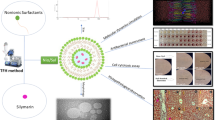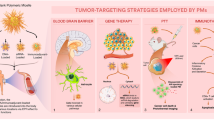Abstract
In this article, we report the synthesis of a novel amphiphilic hydroxypropyl cellulose-based polymer (HPC-PEG-Chol) that contained poly (ethylene glycol) and cholesterol-containing moieties with specific degrees of substitution. The resulting polymer was subsequently converted to a biotin conjugate (HPC-PEG-Chol-biotin), to develop a new potential cancer-targeted drug delivery system. The biotin conjugate was used to prepare micelles via the dialysis method. The polymeric micelles in aqueous solution presented a lower critical solution temperature (LCST) of 39.8 oC. The critical micelle concentration (CMC) values of the polymeric micelles at 25 and 45 °C were evaluated to be about 0.32 and 0. 25 g/L, respectively. Dynamic light scattering (DLS) and transmission electron microscopy (TEM) analyses of the micelles revealed the spherical shapes of the micelles, with 84 nm mean diameters that increased with the increase of the temperature above LCST. The hydrophobic anticancer drug paclitaxel (PTX) was loaded in the micelles and the in vitro release behaviors of PTX were investigated at different temperatures. The release profile of PTX from the polymeric micelles revealed a thermosensitivity, since its release rate was higher at 41 °C than at 37 °C. Fluorescent microscopy analyses confirm that the PTX-loaded HPC-PEG-Chol-biotin is superior in cellular uptake, with very strong adsorption to both HeLa and MDA-MB-231 cancer cell lines. MTT assay in normal cells indicated that HPC-PEG-Chol-biotin micelles have great potential to be safely used in tumor-targeting chemotherapy.










Similar content being viewed by others
References
Jones MC, Leroux JC (1999) Polymeric micelles: A new generation of colloidal drug carriers. Eur J Pharm Biopharm 48:101–111
Nishiyama N, Kataoka K (2006) Current state, achievements, and future prospects of polymeric micelles as nanocarriers for drug and gene delivery. Pharmacol Ther 112:630–648
Hu F-Q, Meng P, Dai Y-Q, Du Y-Z, You J, Wei X-H, Yuan H (2008) PEGylated chitosan-based polymer micelle as an intracellular delivery carrier for anti-tumor targeting therapy. Eur J Pharm Biopharm 70(3):749–757
Gaucher G, Dufresne MH, Sant VP, Kang N, Maysinger D, Leroux JC (2005) Block copolymer micelles: preparation, characterization and application in drug delivery. J Control Release 109:169–188
Wang F, Zhang D, Duana C, Jia L, Feng F, Liu Y, Wang Y, Hao L, Zhang Q (2011) Preparation and characterizations of a novel deoxycholic acid–O-carboxymethylated chitosan–folic acid conjugates and self-aggregates. Carbohydr Polym 84:1192–1200
Scomparin A, Salmaso S, Bersani S, Satchi-Fainaro R, Caliceti P (2011) Novel folated and non-folated pullulan bioconjugates for anticancer drug delivery. Eur J Pharm Sci 42:547–558
Li Y, Liu R, Liu W, Kang H, Wu M, Huang Y (2008) Synthesis, self-assembly, and thermosensitive properties of ethyl cellulose-g-P(PEGMA) amphiphilic copolymers. J Polym Sci A Polym Chem 46:6907–6915
Nath N, Chilkoti A (2002) Creating ‘smart’ surfaces using stimuli responsive polymers. Adv Mater 14:1243–1247
Li W, Tu W, Cao D (2009) Synthesis of thermoresponsive polymeric micelles of PNIPAAm-b-OMMA as a drug carrier for loading and controlled release of prednisolone. J Appl Polym Sci 111:701–708
Porsch C, Hansson S, Nordgren N, MalmstrÖm E (2011) thermoresponsive cellulose-based architectures: tailoring LCST using poly (ethylene glycol) methacrylates. Polym Chem 2:1114–1123
Bagheri M, Shateri S (2012) Thermosensitive nanosized micelles from cholesteryl-modified hydroxypropyl cellulose as a novel carrier of hydrophobic drugs. Iran Polym J 21:365–373
Klug ED (1971) Some properties of water-soluble hydroxyalkyl celluloses and their derivatives. J. Polym. Sci., Part C: Polym. Lett. 9:491.
Zhang Z, Chen L, Zhao C, Bai Y, Deng M, Shan H, Zhuang X, Chen X, Jing X (2011) Thermo- and pH-responsive HPC-g-AA/ AA hydrogels for controlled drug delivery applications. Polymer 52:676–682
Zabaleta V, Campanero MA, Irache JM (2007) An HPLC with evaporative light scattering detection method for the quantification of PEGs and Gantrez in PEGylated nanoparticles. J Pharm Biomed Anal 44:1072–1078
Jiang X, Dai H, Leong KW, Goh SH, Mao HQ, Yang YY (2006) Chitosan-g-PEG/DNAcomplexes deliver gene to the rat liver via intrabiliary and intraportal infusions. J Gene Med 8:477–487
Gao JQ, Eto Y, Yoshioka Y, Sekiguchi F, Kurachi S, Morishige T, Yao XL, Watanabe H, Asavatanabodee R, Sakurai F, Mizuguchi H, Okada Y, Mukai Y, Tsutsumi Y, Mayumi T, Okada N, Nakagawa S (2007) Effective tumor targeted gene transfer using PEGylated adenovirus vector via systemic administration. J Control Release 122:102–110
Vuković L, Khatib FA, Drake SP, Madriaga A, Brandenburg KS, Král P, Onyuksel H (2011) Structure and dynamics of highly PEG-ylated sterically stabilized micelles in aqueous media. J Am Chem Soc 133(34):13481–13488
Pourmoazzen Z, Bagheri M, Entezami AA, Koshki KN (2013) pH-responsive micelles composed of poly (ethylene glycol) and cholesterol-modified poly (monomethyl itaconate) as a nanocarrier for controlled and targeted release of piroxicam. J Polym Res 20:295
Lammers T, Hennink WE, Storm G (2008) Tumour-targeted nano-medicines: principles and practice. Br J Cancer 99:392–397
Na K, Lee TB, Park K-H, Shin E-K, Lee Y-B, Choi H-K (2003) Self-assembled nanoparticles of hydrophobically-modified polysaccharide bearing vitamin H as a targeted anti-cancer drug delivery system. Eur J Pharm Sci 18:165–173
Bian Q, Xiao Y, Lang M (2012) Thermoresponsive biotinylated star amphiphilic block copolymer: Synthesis, self-assembly, and specific target recognition. Polymer 53:1684–1693
Blagosklonny MV, Fojo T (1999) Molecular effects of paclitaxel: Myths and reality. Int J Cancer 83:151–156
Jang M-K, Jeong Y-I, Nah J-W (2010) Characterization and preparation of core–shell type nanoparticle for encapsulation of anticancer drug. Colloids Surf B: Biointerfaces 81:530–536
Douziech-Eyrolles L, Marchais H, Hervé K, Munnier E, Soucé M, Linassier C, Dubois P, Chourpa I (2007) Nanovectors for anticancer agents based on superparamagnetic iron oxide nanoparticles. Int J Nanomedicine 2(4):541–550
Bagheri M, Shateri S (2012) Synthesis and characterization of novel liquid crystalline cholesteryl-modified hydroxypropyl cellulose derivatives. J Polym Res 19:9842–9854
Kosho H, Hiramatsu S, Nishi T (1999) Thermotropic cholesteric liquid crystals in ester derivatives of hydroxypropylcellulose. High Perform Polym 11:41–48
Moore GS, Stupp SI (1990) Room-temperature polyesterification. Macromolecules 23:65–70
Malkoch M, Malmstro E, Hult A (2002) Rapid and efficient synthesis of aliphatic ester dendrons and dendrimers. Macromolecules 35:8307–8314
Niknejad H, Deihim T, Ahmadiani A, Jorjani M, Peirovi H (2012) Permanent expression of midbrain dopaminergic neurons traits in differentiated amniotic epithelial cells. Neurosci Lett 506:22–27
Hu F-Q, Ren G-F, Yuan H, Y-Zh D, Zeng S (2006) Shell cross-linked stearic acid grafted chitosan oligosaccharide self-aggregated micelles for controlled release of paclitaxel. Colloids Surf B: Biointerfaces 50:97–103
Ngawhirunpata T, Wonglertniranta N, Opanasopit P, Ruktanonchai U, Yoksan R, Wasanasuk K, Chirachanchai S (2009) Incorporation methods for cholic acid chitosan-g-mPEG self-assembly micellar system containing camptothecin. Colloids Surf B: Biointerfaces 74:253–259
Jeong JH, Kim SH, Kim SW, PARK TG (2005) In vivo tumor targeting of ODN-PEG-folic acid/PEI polyelectrolyte complex micelles. J. Biomater. Sci. Polymer Edn 16:1409–1419
Siegwart DJ, Oh JK, Gao H, Bencherif SA, Perineau F, Bohaty AK, Hollinger JO, Matyjaszewski K (2008) Biotin-, pyrene-, and GRGDS-functionalized polymers and nanogels via ATRP and end group modification. Macromol Chem Phys 209:2179–2193
Wu Y, Zheng Y, Yang W, Wang Ch HJ, Sh F (2005) Synthesis and characterization of a novel amphiphilic chitosan–polylactide graft copolymer. Carbohydr Polym 59:165–171
Chilkoti A, Dreher MR, Meyer DE, Raucher D (2002) Targeted drug delivery by thermally responsive polymers. Adv Drug Deliv Rev 54:613–630
Yang M, Ding Y, Zhang L, Qian X, Jiang X, Liu B (2007) a. Novel thermosensitive polymeric micelles for docetaxel delivery. J Biomed Mater Res 81:847–858
Nabid MR, Tabatabaei Rezaei SJ, Sedghi R, Niknejad H, Entezami AA, Oskooie HA, Heravin MM (2011) Self-assembled micelles of well-defined pentaerythritol-centered amphiphilic A4B8 star-block copolymers based on PCL and PEG for hydrophobic drug delivery. Polymer 52:2799–2809
Liu H, Farrell S, Uhrich KJ (2000) Drug Release Characteristics of Unimolecular Polymeric Micelles Controlled Release 68:167–174
Y-s W, Jiang Q, R-s L, L-l L, Q-q Z, Y-m W, Zhao J (2008) Self-assembled nanoparticles of cholesterol-modified O-carboxymethyl chitosan as a novel carrier for paclitaxel. Nanotechnology 19:145101–145108
Acknowledgments
The authors would like to thank Iran National Science Foundation for financially supporting this research. We are grateful to Azarbaijan Shahid Madani University Research Council for partial support of this study. The authors' warm thanks are also extended to Ms. Veghar Barri for her assistance with the English language.
Author information
Authors and Affiliations
Corresponding author
Electronic supplementary material
Rights and permissions
About this article
Cite this article
Bagheri, M., Shateri, S., Niknejad, H. et al. Thermosensitive biotinylated hydroxypropyl cellulose-based polymer micelles as a nano-carrier for cancer-targeted drug delivery. J Polym Res 21, 567 (2014). https://doi.org/10.1007/s10965-014-0567-4
Received:
Accepted:
Published:
DOI: https://doi.org/10.1007/s10965-014-0567-4





